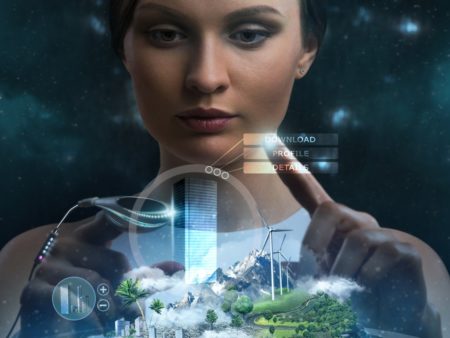Holograms, A.I. and interactive digital signage were basically science fiction, until recently. Today, these three digital advances are a reality. We see them all around us. And we are proud to say, this is the same amazing video technology we use at Bullhorn video. Without video, these amazing technological inventions would not exist.
A Renewal of Our Commitment Bullhorn Readers

Holograms: VR Programs With New and Exciting Applications
The above three topics are only some of the matters we will be discussing in 2019. As we dive into this year, this blog renews its commitment. We will bring you news and information about the technical, digital and video world around you.
Perhaps we will also peek at what is happening just beyond you on the threshold of 2020. Thus, we begin with a blog that features a famous hologram.
The Hologram is a Knight
Perhaps it is fitting that our first story involves a hologram. And that hologram is none other than Sir David Attenborough. The creation of his hologram for the VR program “Hold the World” required 100 video cameras. The cameras surrounded him 360 degrees at various levels. And they looked very much like a cage with several cameras mounted on every bar.
Creating Sir Attenborough’s Hologram: The Volumetric Scanning Technique
The online magazine Wired reported the use of “Volumetric scanning.” This technique uses “multiple video feeds which are compressed to create a 3-D object. The presenter (Attenborough) has been ported into virtual reality.”
Before Attenborough arrived in the US, the Microsoft team repeatedly tested color and lighting. They used a team member dressed in a shirt of Sir Attenborough’s. It was, of course, his favorite color of blue. As he sat in the cage of 106 cameras, he mildly commented, “It’s quite weird.”
The knight was nonplused by all the cameras and technological equipment surrounding him.
But he focused keenly on the project. He stated, “Sharing my passion for the natural world is something which I have done for many years.” He added, “from the days of black-and-white TV to color, HD, 3D, 4K, and now the virtual reality.”
“Hold the World” A Monumental Creation
The project required a village of creators:
It was commissioned by the Sky VR Studio and directed by Dan Smith. “Hold the World” was produced by Factory 42, in association with Dream Reality Interactive and Talesmith. And it was through collaboration with the Natural History Museum’s digital team. The experience is now available on Oculus Rift.
Going Beyond the Glass

Holograms And Reality: Can You Tell the Difference?
Creating the hologram of Sir Attenborough was only part of the project. The Natural History Museum created the VR experience to allow Sir Attenborough to act as your museum mentor. Within the program, you sit across the desk from him. Then, Throughout the VR experience, you will get to hold, touch and feel the some of the treasures of its Natural specimen collection. That is if you have the proper VR equipment.
A spokesperson for the VR project, Hold the World, stated, “The opportunity to bring specimens to life like this has been incredible.” And they added, “Animating the skeletons and fossils within the experience was particularly exciting for our scientists.”
Keep in mind, the very scientists that created this VR experience would never permit you to touch these rare objects. Like any museum, the real specimens are encased in glass and adorned with “Do Not Touch” signs.
A Simple Hologram Review
Observed simply, you could say
- “A hologram is a picture of a “whole” object, showing it in three dimensions.” We have them on credit and ID cards.
- Far more impressive are large holograms that take the form of a ghostly 3-D moving figure. You can walk around it and see from all angles.
- Holograms were invented in 1947. But, they were only perfected after the invention of the laser in 1960. Today they’re used in such technologies as compact-disc players, checkout scanners, and medical education videos.
Props For the Hold the World Hologram
To put it simply, how did they make the specimens? “Hold the World” seem so real? How did they do it? Put simply, they created a “solidity” for each museum object you “hold” with your VR handset. To do this, the scientists “combined 3-D scans with behavioral data.” This is data that “experts have gathered over years of study.”
Their meticulous work has resulted in both stunning and scientifically precise animations. A museum spokesperson commented, “It was a fascinating challenge to work alongside animators to produce an immersive experience that is as accurate as it can possibly be.”
Holograms: Looking Inside “Hold the World” VR
The program allows the participant to choose certain locations in the actual London Natural Museum. Then you handle several specimens as the holograms of Sir Attenborough instructs you about their habits and history.
With your handset in place, you can lift, touch, pet and hold each precious specimen.
You can even zoom in on each of the specimens. It’s as though they were in your hands. It’s like you were moving them closer or further away from you. Then they come to life and move with grace, dimension, and agility.
Sir David Attenborough Encounters Sir David Attenborough
As he faced himself across the desk, he remarked, with astonishment, “Hah! Am I really like that?” And then added, “I suppose I must be, really.” You can see him-and the hologram of himself- in an interesting video clip.
The tape shows you the basic idea. But, it is a pale imitation of the actual VR version.
He was an intrinsic part of the creation of “Hold the World.” And still, he stated “participating in it as an audience member was a new experience.” He added, “Hold the World” allows you to encounter creatures more closely than simply seeing them.”
Interacting with the VR Program (Holograms)
Thanks to the technology of volumetric scanning, the presenter “Sir David Attenborough has been ported into virtual reality.” As stated, “multiple video feeds are compressed to create a 3-D object”
The Knight’s Reactions to the Finished Product
As he watched the project he stated, “It’s quite weird.” A trilobite comes to life. And it scuttles out of the fossilized rock. It crawls across his desk. He exclaims, “What a darling thing!”
As the fossil of pterodactyl dives at him, he genuinely winces. He puts up his hands and rocks sharply sideways. After experiencing the fossils and creatures of the VR, he states, “It’s a whole new relationship with the miracles and marvels of the natural world.”
Museum Travels
The participants can choose from different wings of the museum. You could choose Troy, the Conservation Centre, the Earth Sciences Library, or the Cryptogamic Herbarium. Your VR trip with the hologram can be extended from 20 minutes to a full hour.
The technicians used Photogrammetry to recreate the museum itself in VR.

Holograms: An Exciting New World
The museum’s CT scanning department then worked with museum scientists and animation teams. Their intent was to create a scientifically accurate model. And animation each specimen.
In conclusion, Attenborough stated, “Hold the World’ is an extraordinary next step in how we can communicate and educate people about experiences…” He rightly explained how unique these lessons could be. He said people “wouldn’t usually have access to in the real world.” And he added, “I am delighted about what users can learn and discover from the Museum’s treasures.”
Attenborough concludes, Hold the World “is one of the most convincing and bewitching experiences that the world of technology has yet produced.”
When we blog about projects like this one, it’s inspiring. We can see how far science and technology have taken holograms, VR and video. Other areas, A.I., and digital signage also fascinate and inspire us. We don’t intend to smother our blogs with technological jargon. We simply want you to know a little more about the amazing up-to-date global developments in videography, photography, and media. Events and projects like “Hold the World” bring us a huge opportunity for growth.


